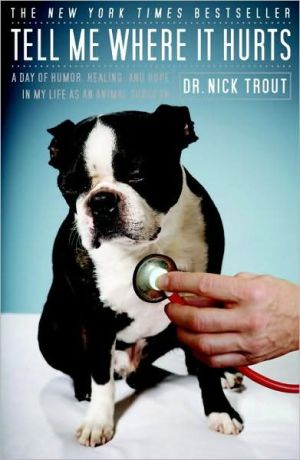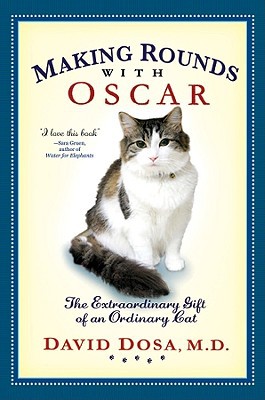Tell Me Where It Hurts: A Day of Humor, Healing and Hope in My Life as an Animal Surgeon
It’s 2:47 a.m. when Dr. Nick Trout takes the phone call that starts another hectic day at the Angell Animal Medical Center. Sage, a ten-year old German shepherd, will die without emergency surgery for a serious stomach condition. Over the next twenty-four hours Dr. Trout fights for Sage’s life, battles disease in the operating room, unravels tricky diagnoses, reassures frantic pet parents, and reflects on the humor, heartache, and inspiration in his life as an animal surgeon. And he wants to...
Search in google:
It’s 2:47 a.m. when Dr. Nick Trout takes the phone call that starts another hectic day at the Angell Animal Medical Center. Sage, a ten-year old German shepherd, will die without emergency surgery for a serious stomach condition. Over the next twenty-four hours Dr. Trout fights for Sage’s life, battles disease in the operating room, unravels tricky diagnoses, reassures frantic pet parents, and reflects on the humor, heartache, and inspiration in his life as an animal surgeon. And he wants to take you along for the ride.…From the front lines of modern medicine, Tell Me Where It Hurts is a fascinating insider portrait of a veterinarian, his furry patients, and the blend of old-fashioned instincts and cutting-edge technology that defines pet care in the twenty-first century. For anyone who’s ever wondered what goes on behind the scenes at your veterinarian’s office, Tell Me Where It Hurts offers a vicarious journey through twenty-four intimate, eye-opening, heartrending hours at the premier Angell Animal Medical Center in Boston.You’ll learn about the amazing progress of modern animal medicine, where organ transplants, joint replacements, and state-of-the-art cancer treatments have become more and more common. With these technological advances come controversies and complexities that Dr. Trout thoughtfully explores, such as how long (and at what cost) treatments should be given, how the Internet has changed pet care, and the rise in cosmetic surgery.You’ll also be inspired by the heartwarming stories of struggle and survival filling these pages. With a wry and winning tone, Dr. Trout offers up hilarious and delightful anecdotes about cuddly (or not-so-cuddly) pets and their variously zany, desperate, and demanding owners. In total, Tell Me Where It Hurts offers a fascinating portrait of the comedy and drama, complexities and rewards involved with loving and healing animals.Part ER, part Dog Whisperer, and part House, this heartfelt and candid book shows that while the technology has changed since James Herriot’s day, the humanity and compassion remains unchanged. If you’ve ever had a pet or special place in your heart for furry friends, Dr. Trout’s irresistible book is for you. The Barnes & Noble Review If the gold standard for writing by a veterinarian is James Herriot's All Things Bright and Beautiful and All Creatures Great and Small, then Dr. Nick Trout's Tell Me Where It Hurts generally achieves the pewter standard, with some sterling-silver highlights. Herriot, whose real name was Alfred Wight, evidently fictionalized some of his narratives, though their grounding in true-life experiences is indubitable. (And, anyway, Oprah can't have Rex or Tabby on her show to, er, rat out a fabricator in this line of work.) Trout, an Englishman who is a staff surgeon at Boston's Angell Animal Medical Center, does the same -- as he acknowledges in his Author's Note at the beginning of the text. He has compressed stories from many different days into one day, altered the names of pets and their owners, and traded "characteristic idiosyncras[ies]...among pets and owners to maintain anonymity."
1\ 2:47 A.M.\ WAKE-UP CALL\ This might seem strange, coming from an Englishman, but sometimes emergency surgery in the middle of the night can play out like a synopsis of a perfect season for the Boston Red Sox. The beginning may be predictably crappy, slow, and discombobulated until a rhythm develops and momentum builds leaving you stricken with that familiar glimmer of hope. When it comes to the final stretch, everyone accepts that there may be failure, there may be disappointment, but the struggle is always gritty and memorable, and occasionally, if you are really lucky, something magical will happen.\ My beginning came half an hour earlier with a phone call reeling me in from a cozy dreamless void.\ "Hello," I said, two disjointed syllables caught in a sticky web at the back of my throat.\ "This is Dr. Keene, one of the new surgical residents. We haven't met but I've got a dog, a ten-year-old spayed female German shepherd; she's bloated and . . . like . . . well . . . I need you to come in for the surgery. Sorry."\ All I heard was sound, not words I could interpret, my brain dormant on my pillow.\ "Hello, are you still there?"\ "Yeah, sure, I'm listening," I croaked, wiping a palm across my face. "What time is it?"\ She told me and dove into her apology.\ "I really hate to disturb you but, like, my backup's not answering his pager and, like, I didn't know what else to do." Her words surfed through me—a Valley Girl inflection—and sluggish gray matter dug out a memory of a recent departmental memo—"Be sure to welcome our first-year surgery resident, Dr. Sarah Keene, from the University of California, Davis."\ I came awake, sat up in bed, and told my wife to go back to sleep.\ "No problem, Dr. Keene. Tell me about your GDV."\ As a new surgery resident, Dr. Keene may know all about GDV, an acronym that stands for gastric dilatation and volvulus, commonly referred to, with a satisfying rustic flavor, as "bloat." But more than likely, at this stage in her training, her understanding is primarily academic, words and phrases in a textbook, disease as bullets of information in shocking fluorescent pink highlights. She will be a year out from veterinary school, a year in which she will probably have diagnosed and managed several cases of GDV. She knows all about this bizarre anatomical aberration and the inevitable, rampant pathology it will incite. She even knows exactly what needs to be done. But, until now, until tonight, she has never been the one who actually picks up a scalpel and makes the cure happen. Tonight, for the first time in her professional career, she is the surgeon on call, and not surprisingly, she is in need of some help.\ GDV is a true veterinary surgical emergency. It typically occurs in deep-chested dogs like German shepherds, Great Danes, and standard poodles but, on occasion, I've even seen it in breeds as small as dachshunds. No one is entirely sure why it happens, but oftentimes the animal eats a large meal, gets some exercise, and an hour or so later the problems begin. Fermented gas starts to accumulate in the distended stomach, and for whatever reason the entire organ twists around and flips over on its long axis. The effect is catastrophic. The twist blocks off the esophagus so despite the poor creature's desire to throw up and rid itself of all that food and gas, nothing will budge. The stomach expands unchecked, destroying its own blood supply, driving into the chest and squashing the lungs and the blood flow back to the heart. There is no absolute timetable for how long an animal can survive in this state, but dogs can die in a matter of hours. As soon as the diagnosis is made, the clock is ticking.\ "She got into a full bag of kibble around seven. Owner took her for a walk before bed. He could hear the dog trying to vomit unsuccessfully around midnight and drove her all the way up from the Cape. She looks ready to explode. Classic double-bubble on abdominal X-rays."\ I had been waiting for this description, the twisted, distended stomach looking like the silhouette of a giant heavyweight's boxing glove on an X-ray. It tells me her diagnosis is correct.\ "Is she stable?" I asked.\ "Not really," said Dr. Keene. "Her pressures are through the floor and we're having a hell of a time just finding a decent vein, let alone placing a catheter."\ My feet were swinging out of the bed and I began to fumble for clean clothes.\ "Do your best. Try to pass a stomach tube. I'll be there as fast as I can."\ Angell Animal Medical Center, part of the Massachusetts Society for the Prevention of Cruelty to Animals, is located in the eclectic and increasingly gentrified Boston neighborhood of Jamaica Plain. There are no world rankings of veterinary hospital size, but at 185,000 square feet I imagine Angell is one of the larger ones, with over seventy veterinarians serving nearly fifty thousand dogs, cats, and exotic pets every year.\ After ten years on staff as a surgeon, I know that those nasty rumors about Boston traffic are all subterfuge because at three in the morning, an easy commute is rewarded with my pick from one of the primo parking spots close to the front door.\ It is January in New England. There are a couple of inches of snow on the ground, a miniature version of the Andes has been plowed against the perimeter wall, and today's high will be only ten below. I walk across the salted asphalt like a geriatric with a bad case of hemorrhoids, poised to slip on the black ice. Despite the hour, my sleepiness is starting to burn off like fog on an imaginary sunny morning as I enter this five-story brick building and head toward the nonsterile surgical prep area. The corridors are empty, floors polished, phones silent, and pagers dead. I have entered an antiseptic ghost town and I like the way it feels. It reminds me of being a kid again, of breaking into the neighbor's backyard in order to steal the ripe apples taunting me from their tree. The mission is covert, even risky—all but guaranteeing the rewards will make it worthwhile.\ Cutting through the radiology department, I catch a glimpse of my reflection in the glass window outside the MRI unit. The man I see looks unfamiliar. He has piggy eyes, a pillow-crease scar across his left cheek, and a jaunty case of bed head. Thank goodness my patients never judge me on my appearance.\ My patient lies splayed across a large gurney, nervous nails clawing for purchase on the stainless steel surface. She is a big girl, obviously not lacking for love in the calorie department. Her darting chocolate eyes scream in fear of her strange situation and the changes taking place in her body, but as I enter the room and approach, her broad and bushy tail offers me a couple of friendly beats. I like German shepherds. I grew up with one as a kid, but this gesture strikes me as both uncharacteristic and, at the same time, utterly endearing. Until this moment I have been dealing with an anonymous and remote animal reduced to a list of diseases, conditions, problems, and deformities. Suddenly everything has changed. This animal has a name and a personality. This animal has become my patient. This is the moment when I begin to care.\ I pat her head and run my hand across a soft velvety ear, over her chest and down to the enormous, unyielding abnormality that is her drum-tight abdomen.\ "Hi, sweetheart. You hanging in there?"\ For me, all my patients are "sweethearts" until proven otherwise, whether they are male or female, cute and cuddly Himalayan kittens or slobbering and stoic 250 pounds of bullmastiff.\ Holding a needle and syringe, Dr. Keene, a short, shiny-faced woman with blond hair in a ponytail, turns to me. She can be no more than twenty-five. I wonder if at forty-three I'm getting a little long in the tooth for this game. She glares through sparkly green contacts as though she thought I had been addressing her. I introduce myself, offer my hand, and assure her that I was speaking to our patient.\ "This is Sage," she says, trying to apply an oxygen mask to the dog's snout. "I'm Sarah, and this is Dan." She gestures to a technician I have never met before, although this is not surprising given the hour. For most of us working in a busy animal hospital, being on call for surgical emergencies every other night, every other weekend, is simply not sustainable for more than a couple of years. Nocturnal surgical emergencies are a rite of passage, an inherent requisite in any decent residency program, a privilege to be endured and enjoyed. But now, nearly fifteen years after the completion of my training, my midnight forays into the OR are limited to the one week in every month that I am available as backup to the residents.\ Dan juts a square chin in my direction and gives me a casual " 'sup." He has a pierced right eyebrow and lower lip with colorful sleeves of tattoos running down his arms in perfect contrast to the sallow vampire skin of his face. In different surroundings he might attract attention, but here, working the overnight, he can relax, setting up the EKG leads, sorting out the pulse oximeter, and adjusting the intravenous fluids with an experienced hand.\ There is a small shaved square on Sage's flank where an attempt has been made to release the trapped and expanding gas in the dog's stomach by directly puncturing the organ with a large bore needle. I touch the small red bull's-eye in the center of the bald spot. The skin is impossibly taut. Clearly the attempt failed.\ "No luck with a tube?" I ask, although I know the question is redundant. If they had successfully passed a stomach tube, the preferred method of decompression, there would have been no need to try to use a needle.\ Dr. Keene shakes her head.\ "I'm afraid not," she says. "She's in bad shape. Heart rate's two twenty with occasional VPCs. Her color looks like shit."\ I'm not surprised. The shock to Sage's circulation has convinced her heart that she is running an endless sprint. This effect combined with the absorption of toxic by-products via the damaged stomach can produce runs of abnormal and ineffective heartbeats called VPCs or ventricular premature contractions. Heard over a heart monitor, VPCs make the beat of a frenetic African tribal dance sound like the cord changes of a funeral march. They can be disastrous in their own right.\ Sage's tail beats a message of thanks as I relieve her of the oxygen mask and lift an upper lip to inspect her gums. Healthy, vibrant pink tissue signifying normal peripheral blood flow has been replaced by an ugly, muddy purple.\ "How much intravenous fluid has she had?"\ "This is her fourth liter," says Dr. Keene. "It took forever to find a vein. Isn't that right, Dan?"\ Dan nods.\ Sage's color looks awful. I imagine someone shoving an overinflated beach ball under my rib cage. I know I wouldn't be faring as well.\ "You're absolutely right," I say. "She looks like crap. You're certain Sage got into the kibble around seven?"\ "According to the owner she did. Why?"\ "Because she's acting like she's near the end, like her stomach has been distended for so long it's going to die. It's all very well trying to get her stable for surgery, but if her stomach dies, she dies. I don't think we have any more time to dick around. Start a lidocaine drip, give her some intravenous antibiotics, and knock her down. The faster we get this thing untwisted the better. I'm going to get changed into scrubs."\ "Before I forget," says Dr. Keene, "the owner is waiting up front. He insisted on meeting with you before you get started."\ Inwardly I groan. Don't get me wrong, good client communication lies at the heart of great veterinary care. There is enormous satisfaction in getting pet owners involved, explaining exactly what it is we are doing, why we are doing it, and making sure they are part of the decision-making process. But right now, with Sage fading fast, every minute lost is a minute closer to a patient who never wakes up from anesthesia. I just want to get going, to give this dog a measure of relief. Perhaps Sage's owner doesn't understand the gravity of the situation. I imagine myself walking into a time trap, forced to engage in idle banter with a belligerent owner about whether I really know what I am doing, how many of these things I have done before, committing to verbal assurances that I will be the one performing the operation and not my resident.\ "Okay," I say, "if I'm not back in five minutes get scrubbed in, drape her off, and start setting up. If I'm not back in ten, page me to the OR, stat."\ I hand comb my hair on the way to the vast waiting room, preparing myself for combat with some sort of aggressive middle aged lawyer type, who, despite the hour, has turned up perfectly coiffed in an immaculate pinstriped suit. But the only person I see is an old man of at least seventy, sitting in a corner, head slightly bowed with one liver-spotted hand tightly clasped in the other. He is bundled up like a snowman, frail skin swaddled in a cap, scarf, and overcoat.\ "Mr. Hartman?" My mind and body rapidly decelerate as I approach.\ The old man looks up, offering an apologetic expression that changes into a wince as he gets to his feet with difficulty. My nose detects the faint, menthol aroma of Bengay.\ "Hi, Mr. Hartman, please don't get up on my account. I understand Dr. Keene has explained that your dog is seriously ill and in need of emergency surgery, so I thought I should introduce myself. I'm Sage's surgeon. I will be the one operating on her this morning."\ Tired, frightened eyes search mine as he extends a cold hand.\ "I'm so very sorry getting you out of bed," he says. "It was my daughter, you see. She's a doctor." I assume he means a doctor of humans. I am pleased to hear him refrain from saying a "real" doctor. MDs appreciate better than most that a hierarchy exists in a referral hospital—student, intern, resident, attending. She probably provoked this insight.\ "She said to make sure to get a surgeon who is on staff, someone with more experience. Not a resident, she said. To be honest, it doesn't bother me. I just don't want to lose her, that's all. Sage is all I've got."
Author's Note ix2:47 A.M. Wake-Up Call 17:24 A.M. Salad Days 217:48 A.M. The Fairer Sex 428:30 A.M. Second Opinion 539:12 A.M. Long Shots and Underdogs 689:21 A.M. Kiss of Death 8810:11 A.M. Dangerous Liaisons 10310:22 A.M. Minor Complications 12710:47 A.M. Supersized! 16010:56 A.M. The Final Straw 17512:01 P.M. Exotic Detour 19112:41 P.M. Bitten! 20712:54 P.M. Extreme Makeover 2232:47 P.M. The Cutting Edge 2346:35 P.M. Foreign Body 25410:02 P.M. Reasonable Doubt 268Acknowledgments 285
\ From Barnes & NobleBarnes & Noble Discover Great New Writers\ Trout desn't usually come to work at 2:47 a.m. A staff surgeon at Boston's Angell Animal Medical Center, he may be starting the day earlier than he would have liked, but he's just learned that Sage, a ten-year-old German shepherd, will die without emergency surgery. Her condition, commonly known as bloat, offers precious little time for reflection and no roomfor error.\ \ From the front lines of veterinary care, Tell Me Where It Hurts is an eye-opening day-in-the-life account of a veterinary surgeon and his four-legged patients. Combining a compassionate bedside manner with cutting-edge technology, Trout takes readers on a 24-hour roller-coaster ride, narrated in his wry and intriguing voice as he introduces us to demanding pet owners, their beloved (but not always lovable) pets, and the extraordinary advances in veterinary medicine. A $40 billion a year industry in the U.S. alone, veterinary care now offers an amazing array of treatments for the 21st-century pet. While the standard, "First, do no harm," remains unchanged, Trout illuminates the controversy surrounding such advanced treatment and the high price it commands.\ \ In this era of dog whisperers and pet therapists, Trout's tale shows that while the times and the technology may have changed since the days of James Herriott, the duty and humanity have not. Humorous, winning, and wise, Tell Me Where It Hurts is an inside look at a fascinating profession. (Summer 2008 Selection)\ \ \ \ \ Publishers WeeklyThough he practices veterinary medicine in Boston, Trout hails from the U.K., so it's fitting that fellow Brit, Simon Vance, narrates. At a couple of points early in the recording, Vance stumbles slightly in bringing to life a few minor figures with pronounced regional American accents. He quickly regains his stride and settles on a style that conveys exact emotions appropriate to the frenetic pace of a large urban animal hospital. With Vance's smooth delivery, Trout's informative asides about the state of his often romanticized and largely misunderstood profession flow nicely into the action. The dramatic tension reaches a climax worthy of ER or Grey's Anatomy, and Vance's portrayal of one family soap opera featuring a lonely widower hoping for a miracle to save the life of his beloved German shepherd and the man's type-A personality daughter angrily dismissing Trout as a misguided purveyor of false hope, proves especially electrifying. Simultaneous release with the Broadway hardcover (Reviews, Dec. 24). (Apr.)\ Copyright © Reed Business Information, a division of Reed Elsevier Inc. All rights reserved.\ \ \ Library JournalModern veterinary medicine is potently explored in this noteworthy debut by a staff surgeon at the Angell Animal Medical Center in Boston. The 24-hour romp Trout describes includes a riveting midnight foray into the operating room; compelling stories about individual patients (Sage, a ten-year-old German shepherd in need of emergency surgery; Woody, a geriatric Labrador diagnosed with aggressive cancer; Chunky Bear, a corpulent 40-pound cat; and Thor, a bisexual male boxer with profoundly pendulous breasts); and curious tête-à-têtes with demanding, devoted, and disgruntled pet owners. With refreshing frankness, Trout offers lucid observations on animal-human relationships ("Companion animals have moved from the periphery of the American family to its center in a love affair that has shifted the paradigm from accessory to necessity, from mere property pet to the status of an adopted child. Pet owners are now pet parents"). Trout thoughtfully considers the myriad of treatment options available for 21st-century pets, the impact of technology on the veterinary profession, and larger ethical and quality-of-life issues. Recommended for all libraries. [See Prepub Alert, LJ 11/1/07.]-Miriam Tuliao, NYPL\ Copyright 2006 Reed Business Information.\ \ \ \ \ Kirkus ReviewsA seasoned veterinarian shares some memorable cases. With several decades of experience as a veterinary surgeon, the author has seen his share of animal emergencies, which he now structures as parts of one fictional day, a tactic that detracts from, rather than adds to, the urgency of his narrative. It begins at 2:47 a.m., when Trout is roused out of bed to perform emergency stomach surgery on Sage, a ten-year-old German shepherd who is the sole companion of an aging widower. Next up is a particularly unusual case, a hermaphroditic boxer named Thor who has begun secreting female hormones. Later in the morning the vet helps a family decide whether or not to put a beloved pet to sleep. This sparks a lively discussion of euthanasia, a high point in the book. A 40-pound cat aptly named Chunky Bear inspires Trout's musings on canine and feline obesity, an epidemic nearly as dire as the same among humans. Just past noon, the vet acquires David, a tag-along "shadow" with veterinary aspirations from a nearby high school, and enters the world of small animal plastic surgery. With Tinkerbell, Trout is cleaning up scar tissue from an earlier cancer surgery, but her case causes him to pause and pontificate on more cosmetic procedures, such as ear cropping and tail docking, which he opposes. Later in the afternoon, he embarks on a canine hip replacement. Finally, he ends his day with a cat named Snowball, who managed to swallow one of her own teeth. Trout brings up some interesting ethical issues, but readers looking for a heart-warmer will be bored by these tangents, and intellectuals will feel belittled by the tongue-in-cheek prose and frenetic pacing. Steadfast animal lovers might be willing tooverlook Trout's inconsistent tone, but he's unlikely to garner a wide audience.\ \ \ \ \ The Barnes & Noble ReviewIf the gold standard for writing by a veterinarian is James Herriot's All Things Bright and Beautiful and All Creatures Great and Small, then Dr. Nick Trout's Tell Me Where It Hurts generally achieves the pewter standard, with some sterling-silver highlights. Herriot, whose real name was Alfred Wight, evidently fictionalized some of his narratives, though their grounding in true-life experiences is indubitable. (And, anyway, Oprah can't have Rex or Tabby on her show to, er, rat out a fabricator in this line of work.) Trout, an Englishman who is a staff surgeon at Boston's Angell Animal Medical Center, does the same -- as he acknowledges in his Author's Note at the beginning of the text. He has compressed stories from many different days into one day, altered the names of pets and their owners, and traded "characteristic idiosyncras[ies]...among pets and owners to maintain anonymity." \ Still, despite these liberties and despite some chronic shortcomings, Tell Me Where It Hurts manages to convey, often with drama and humor, what a modern vet's professional life is like. Running through the "day" here is the story of Sage, a German shepherd suffering from gastric dilation and vovulus (in which the stomach of a dog sort of flips over) and her owner, Mr. Hartmann, for whom Sage has been a lifeline since the death of his wife. Dr. Trout -- summoned to the medical center early in the morning -- and a young resident discuss the surgery needed to correct this problem and the procedure's possible complications:\ Mortality rates for GDV can be as high as 60 per cent, and factors associated with a higher chance of death include abnormal heart rhythms, extremely high pulse rates, the need to cut out part of the stomach....Sage had checked off nearly every negative prognostic factor for survival.\ Trout uses Sage's story as a sort of clothesline from which to hang other stories and dilemmas and statistics and veterinary issues. In this book resembles any number of contemporary accounts of a professional life -- such as Dr. Katrina Firlik's recent book about being a brain surgeon, Another Day in the Frontal Lobe -- in which anecdote mixes with background and commentary. Here we learn that some 69 million Americans own pets; that a vet specializing in "exotics" can cut off a turtle's penis, after his (the turtle's!) girlfriend has already bitten half of it off, with no adverse functional effect, as the organ plays no role in micturition; that the toughest decision a vet has to make is, as you might guess, whether to advocate putting a pet to sleep; that, perhaps consequently, veterinarians' suicide rates are very high; that American pets mirror their owners' obesity problems; that cosmetic surgery for animals is against the law in England; that putting two ferrets in your pants, making sure they can't escape, and attempting to endure the consequent fighting and biting within is an old sport in England, called by the uninspired and very Monty Pythonesque name "ferret-legging." The record is held by Reg Mellor, of Yorkshire: 5 hours and 26 minutes. \ Some of the more entertaining and powerful moments here include a spirited defense of animal euthanasia when it is clearly called for. In response to those who advocate letting nature take its slow and painful course, Trout exclaims, "Sometimes nature can take its course and shove it!" Another strong passage describes Trout's own introduction to veterinary medicine, at his father urging, while he was in high school in England. He accompanied a Welsh vet named Ryan James on his rounds. James was a charismatic, no-nonsense practitioner who in one day showed young Nick Trout what vets did, including injecting a bull's eyeball to cure pink eye (James made Trout do one of the injections), pulling the teeth of a Pekingese, and earning a patient's owner's trust by letting him or her see how conscientious you are at the very beginning of a consultation: "Make a show of cleaning your table in front of the client," James says.\ Tell Me Where It Hurts hurts a little when Trout tries too hard -- or, maybe, not hard enough -- to be funny. In discussing the famous rash of cat self-defenestration in high-rise New York apartment buildings in 1987 --132 in five months -- and their surprising survival rates, Trout says, "I don't know about dogs but it must have been raining cats in Manhattan that year." Please! And he gives us his efforts at witty ripostes that often turn out not to have been actually riposted. "You really think he's fat?" a pet owner might say to Trout. "Well...[he] certainly would benefit from a little dietary discretion. But then again, so could you." Trout then tells us that this last sentence in truth remained "unsaid." And the book's structure, which involves many chronological shifts and subject jumps, presents its own challenges.\ The best aspect of this book is its obvious understanding of and sympathy with pet owners' love for their animals. The origin of this recognition is easily found in Trout's own childhood connection with his family's German shepherd, Patch, who suffered a painful and saddening deterioration before he died. The second best is the polar opposite: the clinical explanations of pets' afflictions and the surgical steps required to treat them -- notably resetting a goose's wing bones and removing a nerve-sheath tumor from a canine's armpit. Since there are 69 million American pet owners, and many of them are pushovers when it comes to animal stories, as we can see from the enormous success of some recent books about dogs, the prognosis for Tell Me Where It Hurts may be quite positive.\ I will not tell you what happens to Sage and her widowed owner, Mr. Hartmann. Take a guess. --Daniel Menaker\ Author of the novel The Treatment and two books of short stories, Daniel Menaker is former Executive Editor-in-Chief of Random House and fiction editor of The New Yorker. His reviews, humor pieces, and other writings have appeared in The New Yorker, The New York Times, and Slate. He is currently the host of the web-based book program titlepage.tv.\ \ \








